High-Order Wideband Band-Pass Miniaturized Frequency-Selective Surface with Enhanced Equivalent Inductance
Abstract
:1. Introduction
2. Review of Traditional Fourth-Order Band-Pass Miniaturized FSS Designs
2.1. Geometry and Equivalent Circuit Model of Traditional Fourth-Order Miniaturized FSSs
2.2. S-Parameters of Traditional Fourth-Order Miniaturized FSSs
2.3. Discussion of Transmission Zeros in High-Frequency Stop-Band during TM Oblique Incidence
3. Wideband Band-Pass Miniaturized FSS Designs with Large Equivalent Inductance
3.1. Geometry and Equivalent Circuit Model of Modified Miniaturized FSSs
3.2. S-Parameters of Modified Miniaturized FSSs
4. Experiment Verification
| Ref. | Reported Year | 2.5-D/3-D (Unit Cell) | Polarization | Fractional Bandwidth (3 dB) | Size of the Unit Cell and FSS Thickness | Angular Stability |
|---|---|---|---|---|---|---|
| [6] | 2009 | 2.5-D | Dual | 20% | 0.19 λ0 × 0.19 λ0 × 0.02 λ0 | 45° |
| [8] | 2016 | 3-D | Dual | 24% | 0.3 λ0 × 0.3 λ0 × 2 λ0 | 40° |
| [9] | 2022 | 3-D | Single | 119% | 0.23 λ0 × 0.093 λ0 × 0.46 λ0 | 45° |
| Design A in [15] | 2020 | 3-D | Single | 91% | 0.16 λ0 × 0.16 λ0 × 0.97 λ0 | 40° |
| Design B in [15] | 2020 | 3-D | Single | 73% | 0.15 λ0 × 0.15 λ0 × 0.82 λ0 | 40° |
| Design C in [15] | 2020 | 3-D | Single | 123% | 0.16 λ0 × 0.16 λ0 × 0.78 λ0 | 40° |
| [16] | 2022 | 3-D | Single | 15.8% | 0.22 λ0 × 0.22 λ0 × 0.29 λ0 | 60° |
| [27] | 2020 | 2.5-D | Dual | 5.1% | 0.19 λ0 × 0.19 λ0 × 0.02 λ0 | 40° |
| Modified design A in this paper | 2024 | 2.5-D | Dual | 71.6% | 0.16 λ0 × 0.16 λ0 × 0.284 λ0 | 40° |
| Modified design B in this paper | 2024 | 2.5-D | Dual | 71.6% | 0.16 λ0 × 0.16 λ0 × 0.279 λ0 | 40° |
5. Conclusions
Author Contributions
Funding
Data Availability Statement
Acknowledgments
Conflicts of Interest
References
- Munk, B.A. Frequency Selective Surface: Theory and Design; Wiley: Hoboken, NJ, USA, 2000. [Google Scholar]
- Anwar, R.S.; Mao, L.; Ning, H. Frequency Selective Surfaces: A Review. Appl. Sci. 2018, 8, 1689. [Google Scholar] [CrossRef]
- Xu, Y.; He, M. Design of multilayer frequency-selective surfaces by equivalent circuit method and basic building blocks. Int. J. Antennas Propag. 2019, 2019, 9582564. [Google Scholar] [CrossRef]
- Kapoor, A.; Mishra, R.; Kumar, P. Frequency selective surfaces as spatial filters: Fundamentals, analysis and applications. Alex. Eng. J. 2022, 61, 4263–4293. [Google Scholar] [CrossRef]
- Narayan, S.; Jha, R.M. Electromagnetic Techniques and Design strategies for FSS Structure Applications [Antenna Applications corner]. IEEE Antennas Propag. Mag. 2015, 57, 135–158. [Google Scholar] [CrossRef]
- Al-Joumayly, M.; Behdad, N. A New Technique for Design of Low-Profile, Second-Order, Bandpass Frequency Selective Surface. IEEE Trans. Antennas Propag. 2009, 57, 452–459. [Google Scholar] [CrossRef]
- Al-Joumayly, M.A.; Behdad, N. A Generalized Method for Synthesizing Low-Profile, Band-Pass Frequency Selective Surfaces with Non-Resonant Constituting Elements. IEEE Trans. Antennas Propag. 2010, 58, 4033–4041. [Google Scholar] [CrossRef]
- Liang, B.; Bai, M. Subwavelength three-dimensional frequency selective surface based on surface wave tunneling. Opt. Express 2016, 24, 14697. [Google Scholar] [CrossRef] [PubMed]
- Jiang, X.; Rashid, A.K.; Xu, W.; Cheng, Q.; Shao, L.; Zhang, Q. An Ultrawideband Three-Dimensional Bandpass Frequency Selective Surface. IEEE Antennas Wirel. Propag. Lett. 2022, 21, 1238–1242. [Google Scholar] [CrossRef]
- Choudhary, D.K.; Mishra, N.; Singh, P.K.; Sharma, A. Miniaturized Power Divider with Triple-Band Filtering Response Using Coupled Line. IEEE Access 2023, 11, 27602–27608. [Google Scholar] [CrossRef]
- Choudhary, D.K.; Chaudhary, R.K. Compact Lowpass and Dual-Band Bandpass Filter with Controllable Transmission Zero/Center Frequencies/Passband Bandwidth. IEEE Trans. Circuits Syst. II Express Briefs 2020, 67, 1044–1048. [Google Scholar] [CrossRef]
- Choudhary, D.K.; Chaudhary, R.K. Compact Multiband Metamaterial Filter. In Handbook of Nano-Metamaterials; Choudhury, B., Tewary, V.K., Eds.; Springer: Singapore, 2021; Volume 1, pp. 1–34. [Google Scholar]
- Choudhary, D.K.; Chaudhary, R.K. A Compact via-Less Metamaterial Wideband Bandpass Filter Using Split Circular Rings and Rectangular Stub. Prog. Electromagn. Res. Lett. 2018, 72, 99–106. [Google Scholar] [CrossRef]
- Li, H.; Li, B.; Zhu, L. Wideband Linear-to-Circular Polarizer Based on Orthogonally Inserted Slot-Line Structures. IEEE Antennas Wirel. Propag. Lett. 2019, 18, 1169–1173. [Google Scholar] [CrossRef]
- Li, H.; Li, B.; Zhu, L. Wideband Bandpass Frequency-Selective Structures on Stacked Slotline Resonators: Proposal and Synthetic Design. IEEE Trans. Antennas Propag. 2020, 68, 7068–7078. [Google Scholar] [CrossRef]
- Zhang, W.; Li, B.; Zhu, L.; Zhao, X.; Lyu, Y.P.; Cheng, C.H. Synthesis Design of Bandpass Frequency Selective Surface with Multiple Transmission Zeros Using Slotline Structures. IEEE Trans. Antennas Propag. 2022, 70, 9449–9459. [Google Scholar] [CrossRef]
- Katoch, K.; Jaglan, N.; Gupta, S.D.; Sharawi, M.S. Design of a triple band notched polarization independent compact FSS at UWB frequency range. Int. J. RF Microw. Comput. Eng. 2021, 31, e22631. [Google Scholar] [CrossRef]
- Katoch, K.; Jaglan, N.; Gupta, S.D. Design and Analysis of Single Sided Modified Square Loop UWB Frequency Selective Surface. IEEE Trans. Electromagn. Compat. 2021, 63, 1423–1432. [Google Scholar] [CrossRef]
- Katoch, K.; Jaglan, N.; Gupta, S.D. Analysis and design of a simple and compact bandstop frequency selective surface at mobile WiMAX and satellite communication X-band. J. Electromagnet Wave Appl. 2021, 35, 1321–1336. [Google Scholar] [CrossRef]
- Hussain, T.; Cao, Q.; Kayani, J.K.; Majid, I. Miniaturization of Frequency Selective Surfaces Using 2.5-D Knitted Structures: Design and Synthesi. IEEE Trans. Antennas Propag. 2017, 65, 2405–2412. [Google Scholar] [CrossRef]
- Hua, B.; He, X.; Yang, Y. Polarisation-independent UWB frequency selective surface based on 2.5D miniaturised hexagonal ring. Electron. Lett. 2017, 53, 1502–1504. [Google Scholar] [CrossRef]
- Li, D.; Li, T.; Li, E. Implementation of ultra-miniaturised frequency-selective structures based on 2.5D convoluted segments. Electron. Lett. 2018, 54, 476–478. [Google Scholar] [CrossRef]
- Niaz, M.W.; Yin, Y.; Chen, J. Synthesis of Ultraminiaturized Frequency-Selective Surfaces Utilizing 2.5-D Tapered Meandering Lines. IEEE Antennas Wirel. Propag. Lett. 2020, 19, 163–167. [Google Scholar] [CrossRef]
- Duarte, M.J.; da Silva Neto, V.P.; D’Assunção, A.G. A New Miniaturized Low-Profile and Stable Dual-Band FSS with 2.5D Structure for ISM Bands. J. Microw Optoelectron. Electromagn. Appl. 2022, 21, 445–452. [Google Scholar] [CrossRef]
- Duarte, M.J.; D’Assunção, A.G., Jr.; da Silva Neto, V.P.; d’Assunção, A.G. A New Ultraminiaturized Low-profile and Stable FSS with 2.5D Structure for 900 MHz ISM Band. J. Commun. Inf. Syst. 2023, 38, 9–13. [Google Scholar]
- Abadi, S.M.A.M.H.; Li, M.; Behdad, N. Harmonic-Suppressed Miniaturized-Element Frequency Selective Surfaces with Higher Order Bandpass Responses. IEEE Trans. Antennas Propag. 2014, 62, 2562–2571. [Google Scholar] [CrossRef]
- Liao, R.X.; Wong, S.W.; Li, Y.; Lin, J.Y.; Liu, B.Y.; Chen, F.C.; Quan, Z. Quasi-Elliptic Bandpass Frequency Selective Surface Based on Coupled Stubs-Loaded Ring Resonators. IEEE Access 2020, 8, 113675–113682. [Google Scholar] [CrossRef]
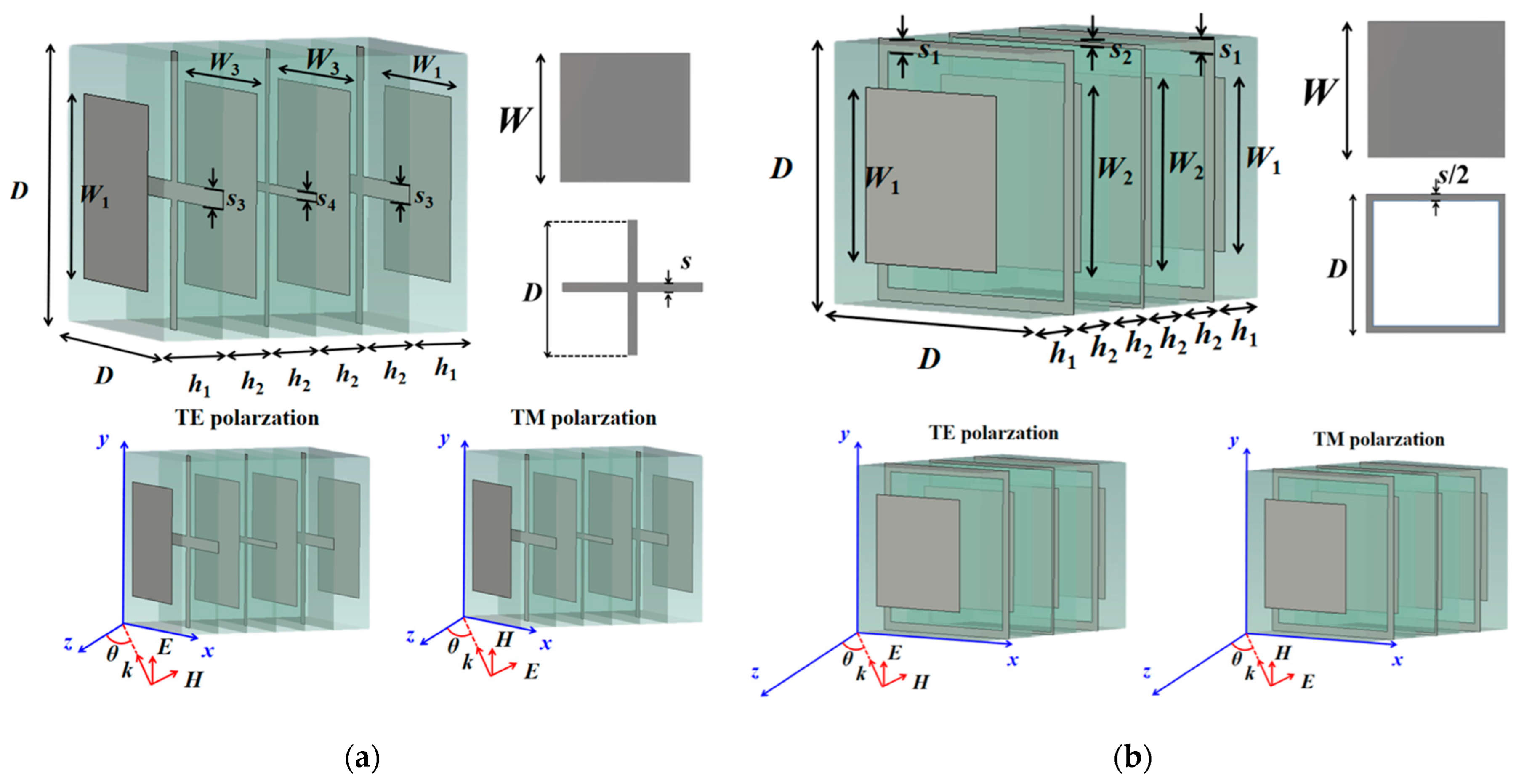



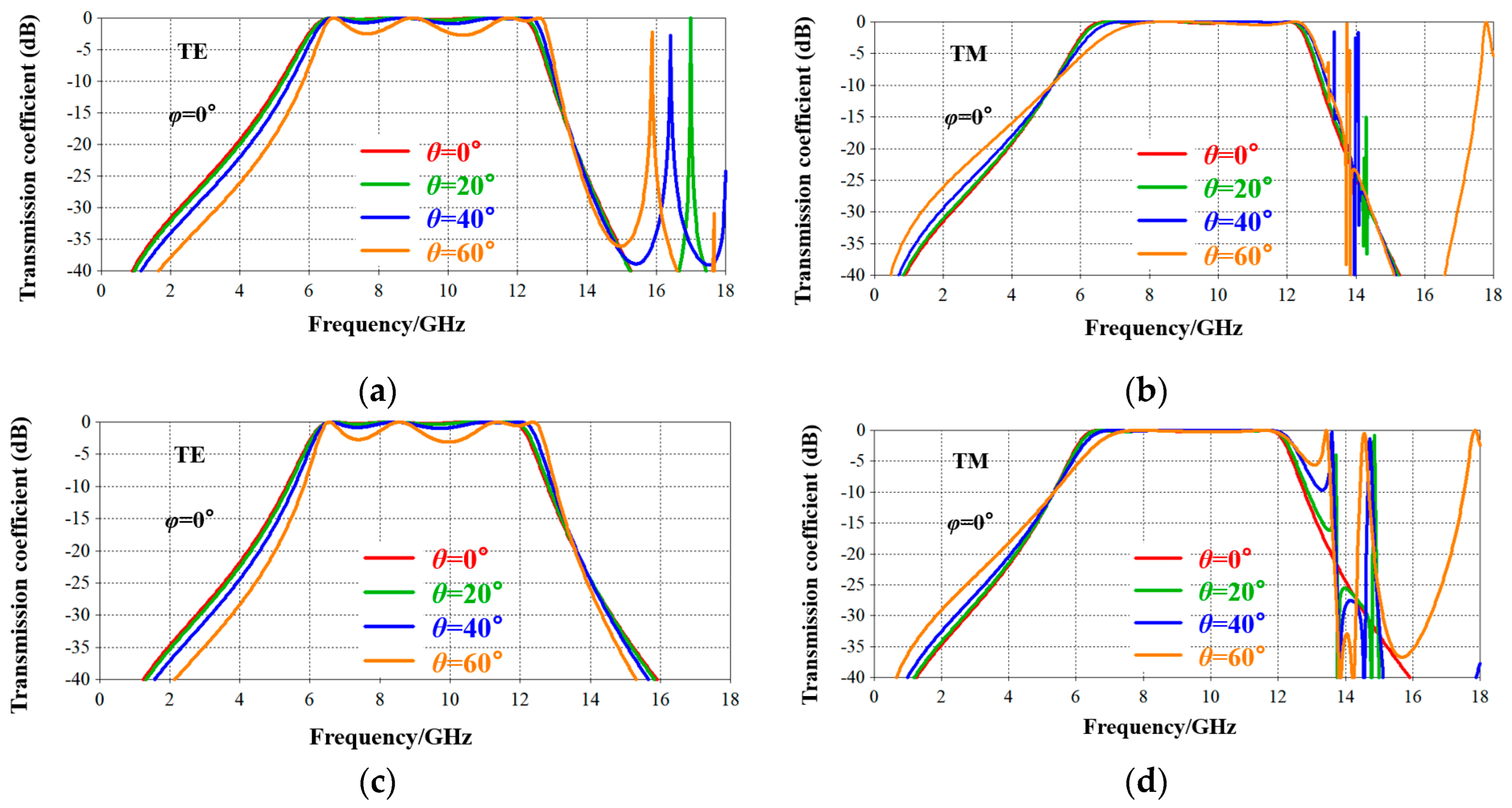
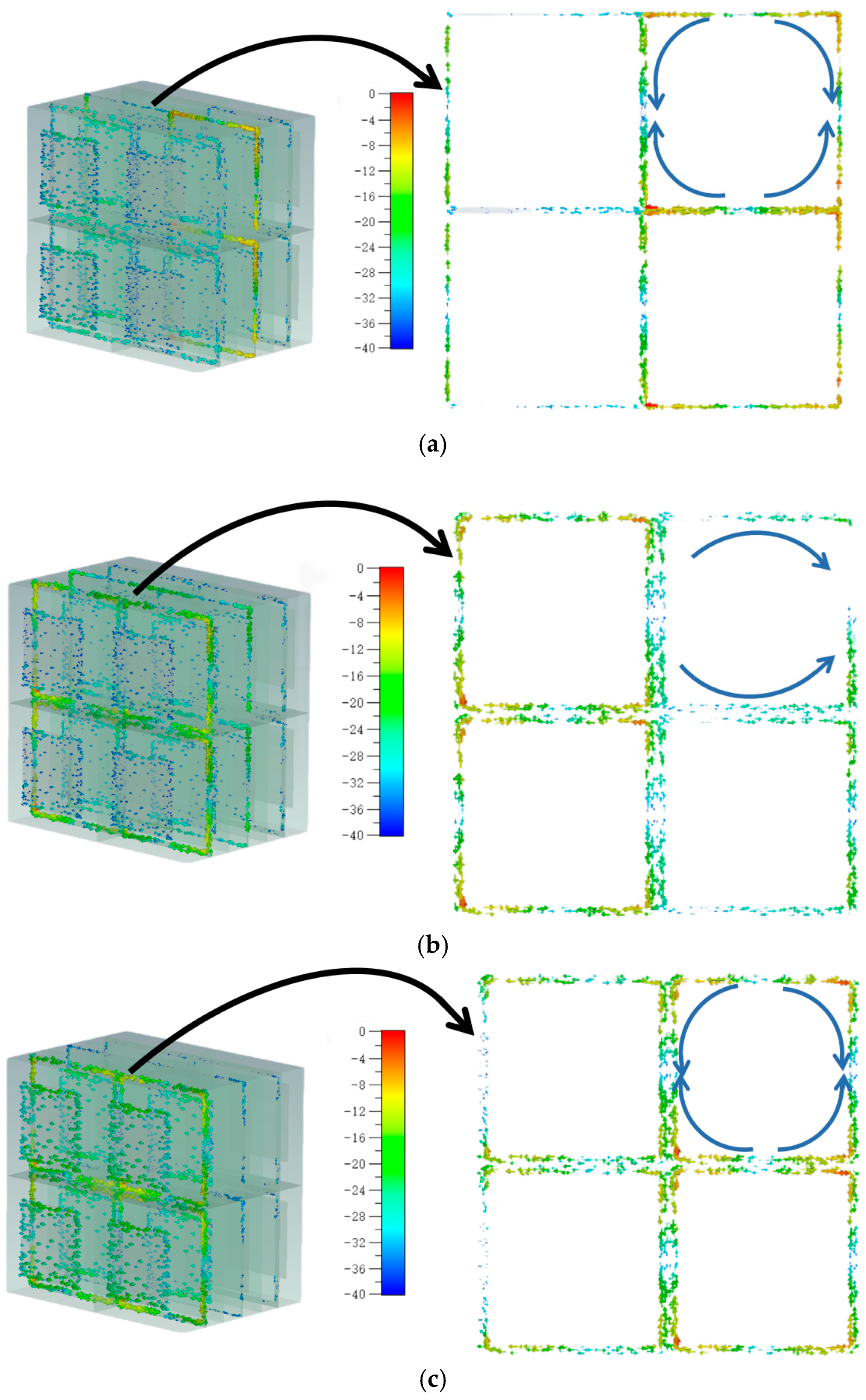
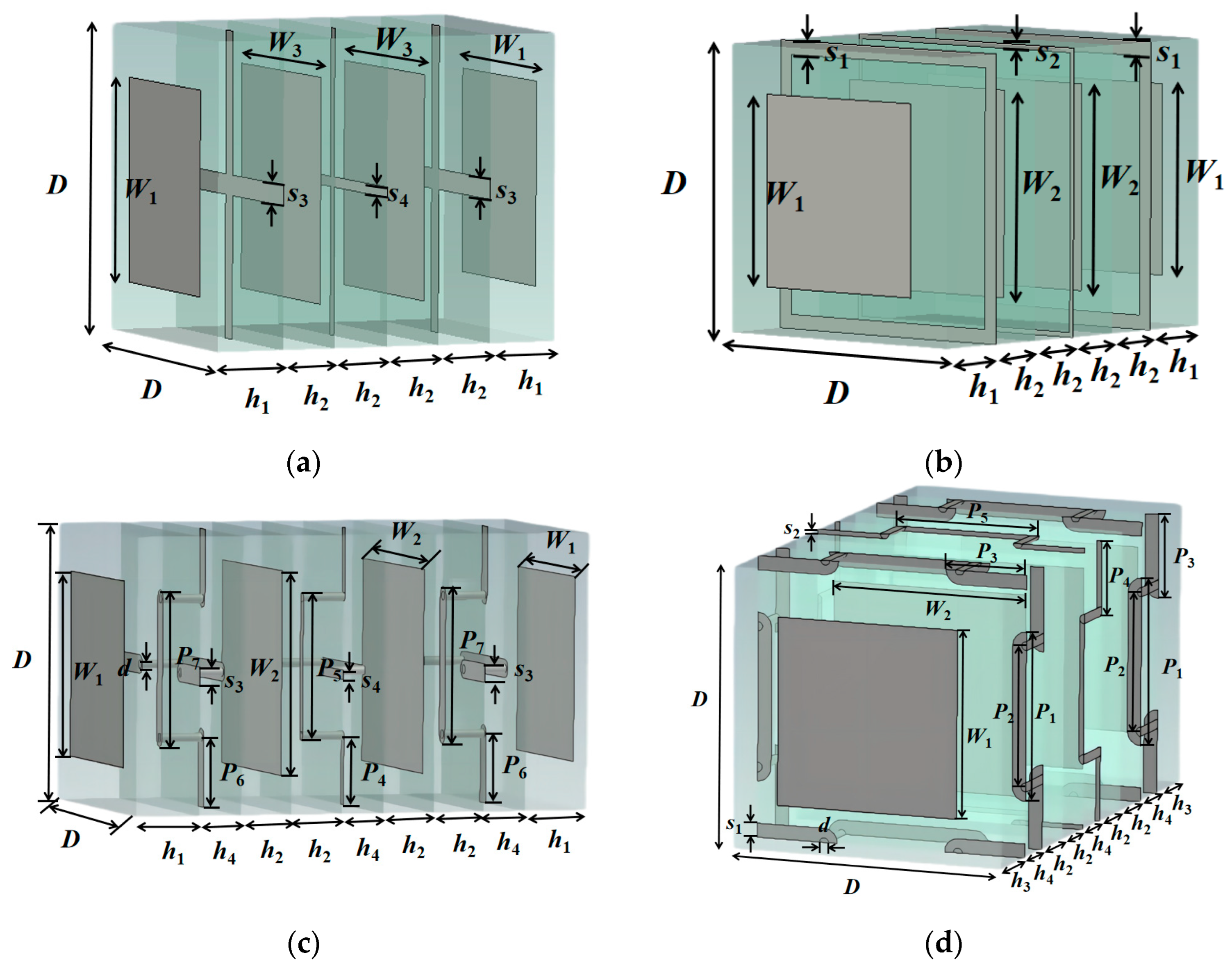




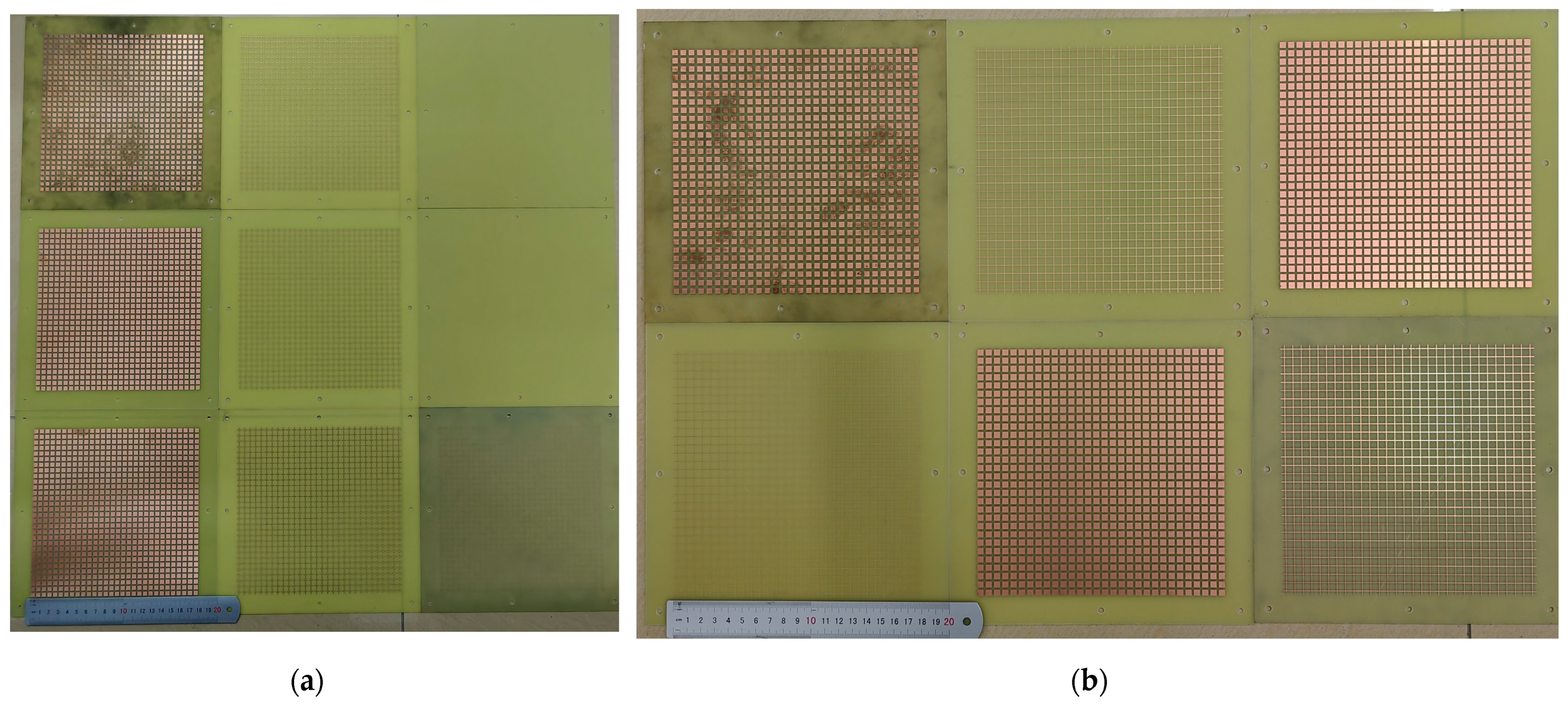
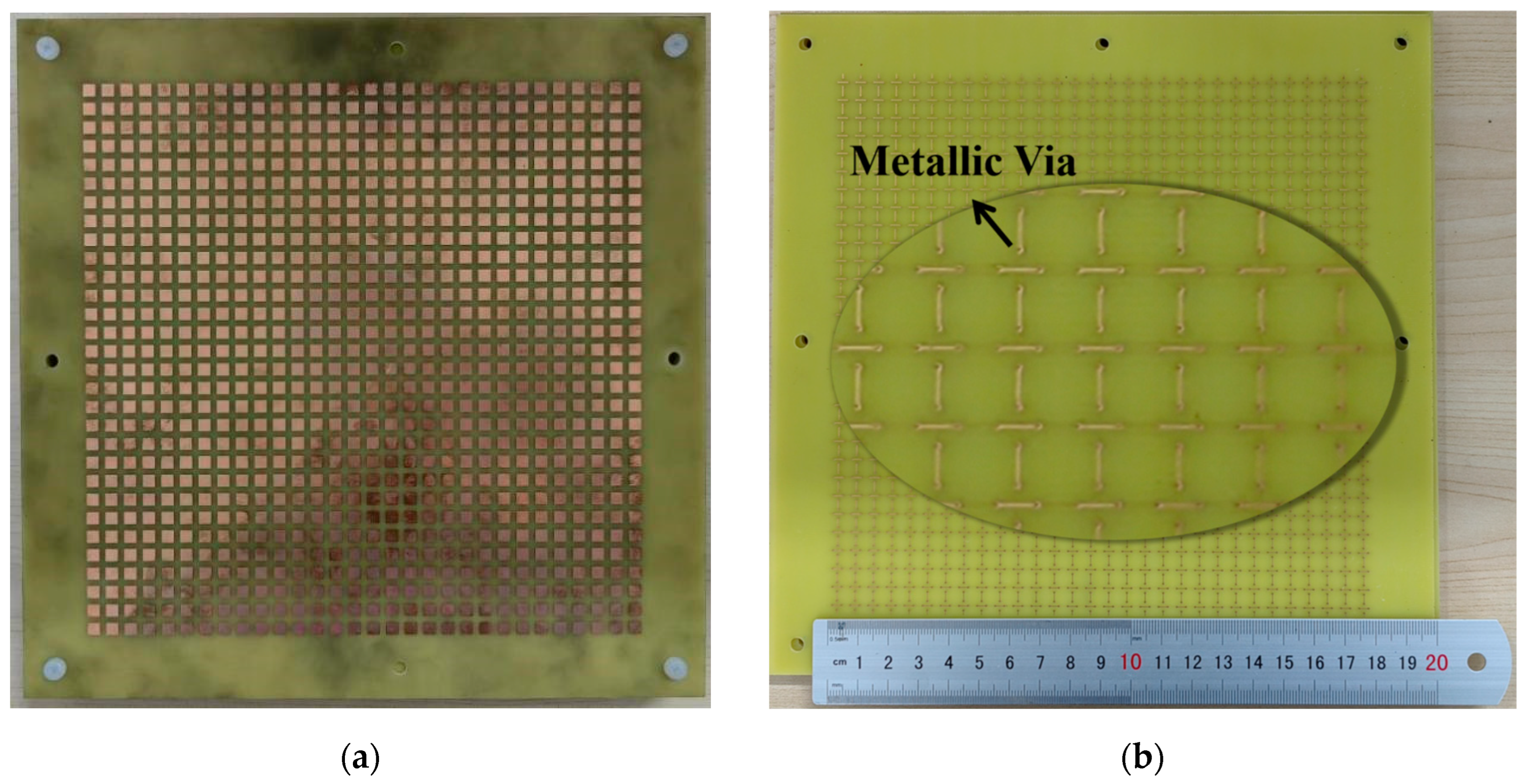
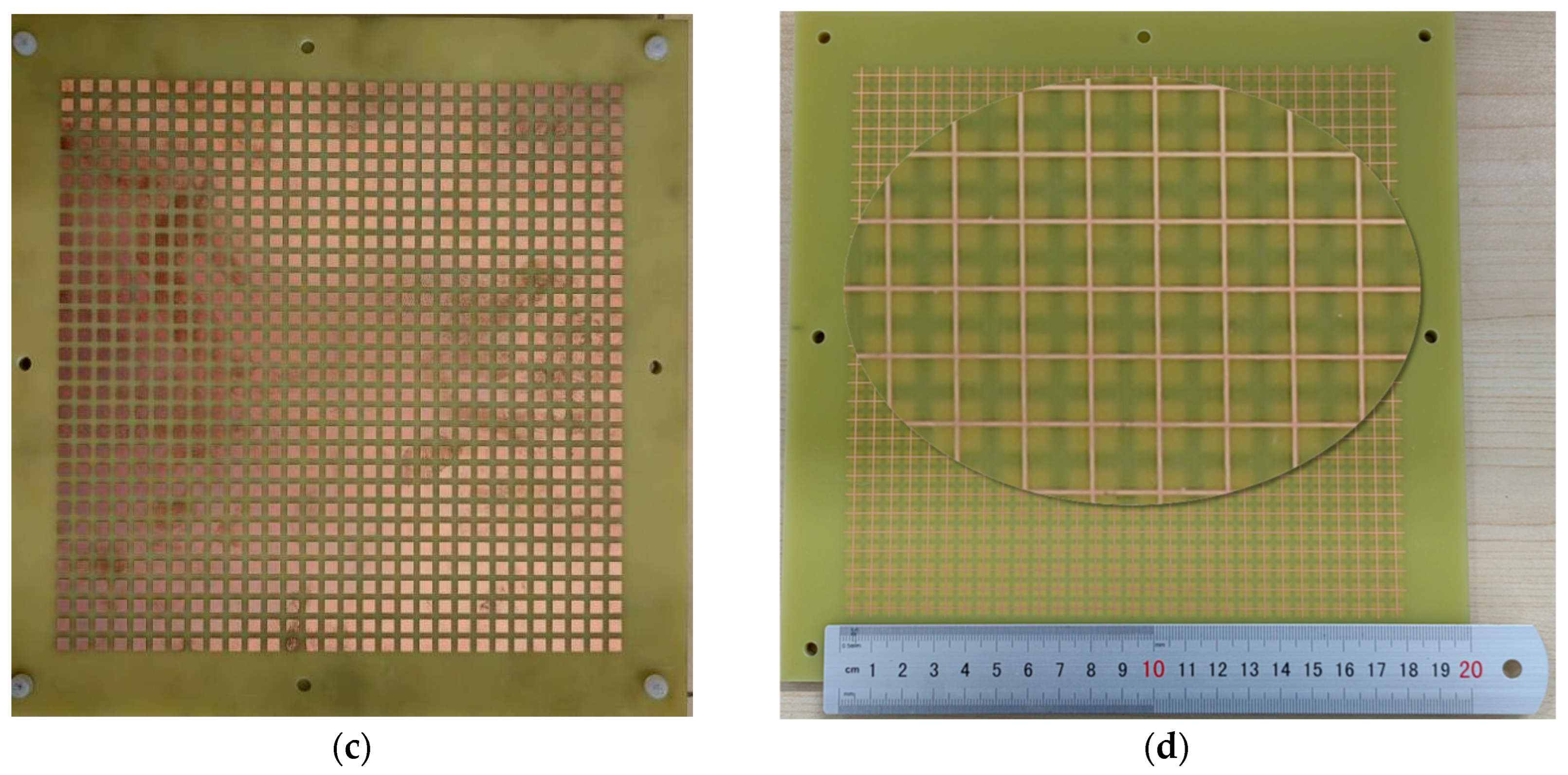
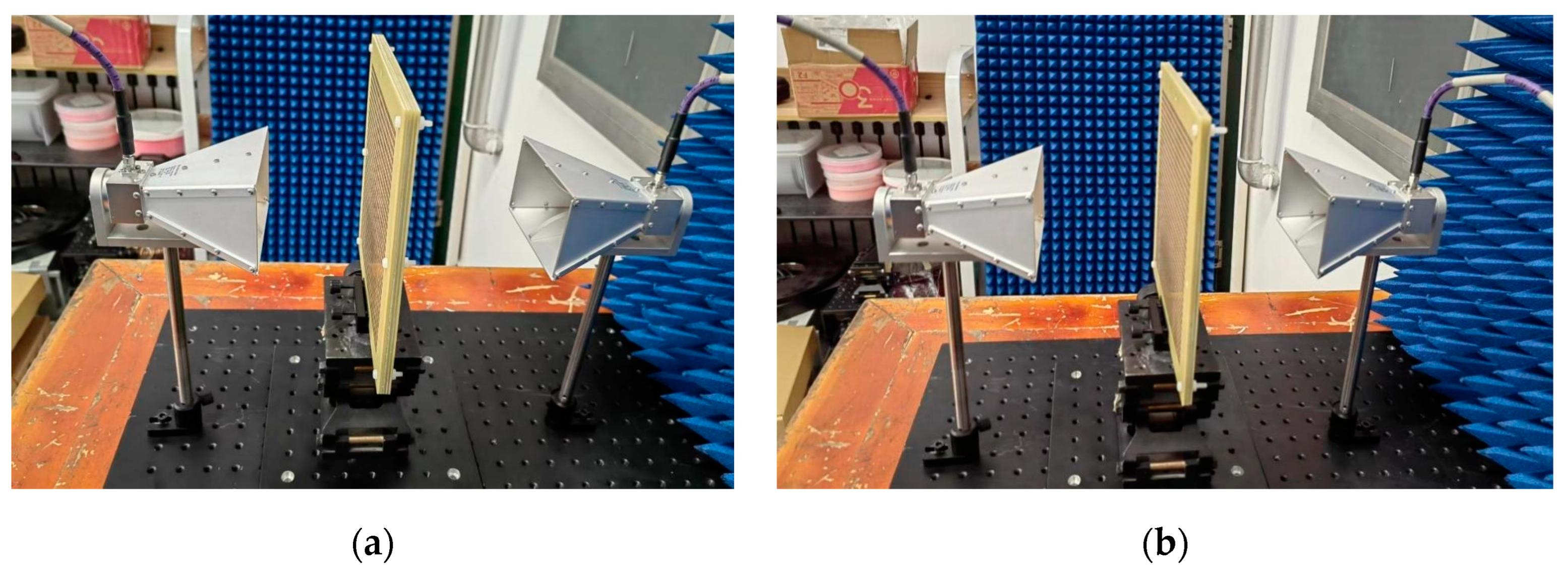

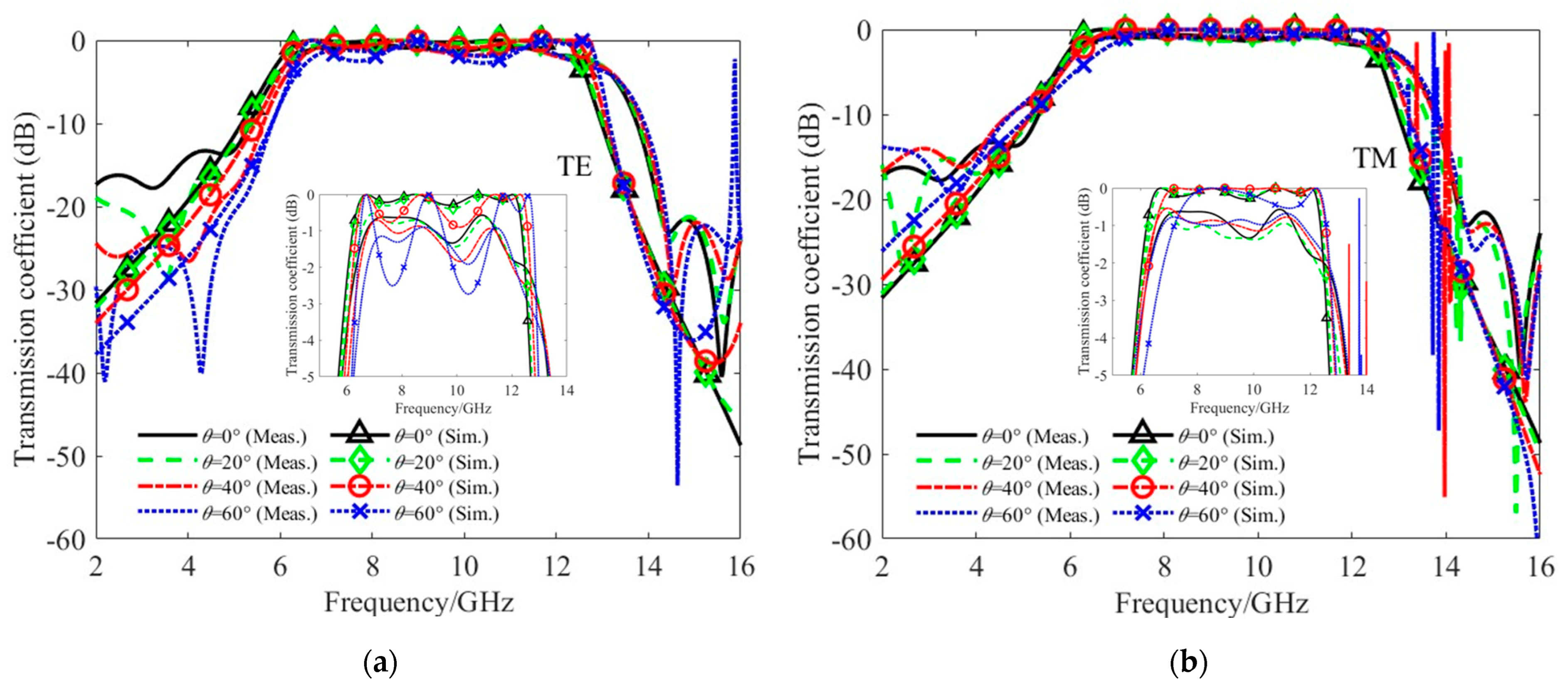
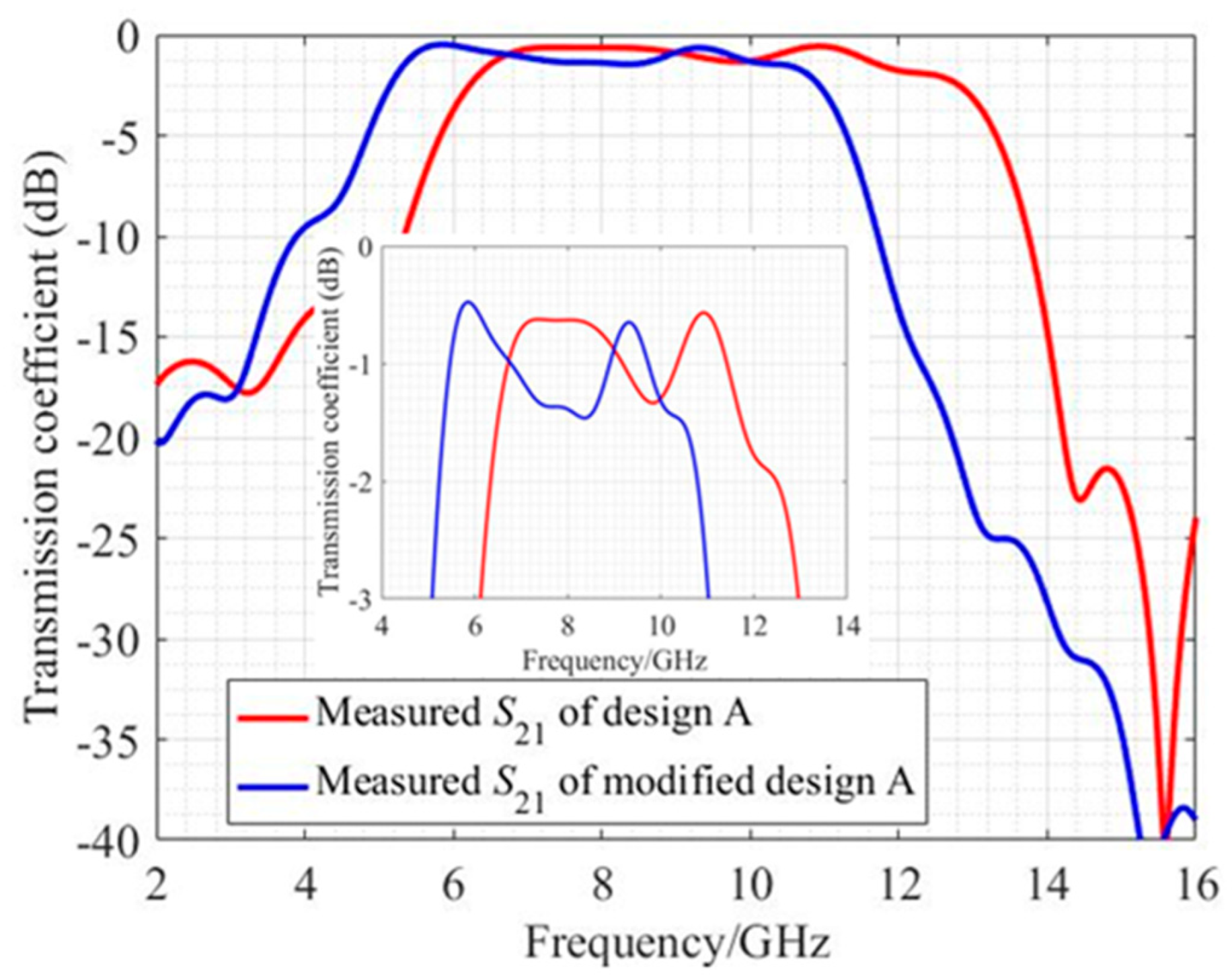
| Parameters | D | W1 | W2 | W3 | s1 |
| Values | 6 mm | 4 mm | 4.3 mm | 4.4 mm | 0.3 mm |
| Parameters | s2 | s3 | s4 | h1 | h2 |
| Values | 0.1 mm | 0.4 mm | 0.2 mm | 1.5 mm | 1.2 mm |
| Parameters | D | W1 | W2 | W3 | s1 |
| Values | 6 mm | 4 mm | 4.3 mm | 4.4 mm | 0.3 mm |
| Parameters | s2 | s3 | s4 | h1 | h2 |
| Values | 0.1 mm | 0.4 mm | 0.2 mm | 1.5 mm | 1.2 mm |
| Parameters | h3 | h4 | P1 | P2 | P3 |
| Values | 1.4 mm | 1 mm | 3.6 mm | 3 mm | 1.8 mm |
| Parameters | P4 | P5 | P6 | P7 | d |
| Values | 1.6 mm | 3.2 mm | 1.5 mm | 3.4 mm | 0.2 mm |
Disclaimer/Publisher’s Note: The statements, opinions and data contained in all publications are solely those of the individual author(s) and contributor(s) and not of MDPI and/or the editor(s). MDPI and/or the editor(s) disclaim responsibility for any injury to people or property resulting from any ideas, methods, instructions or products referred to in the content. |
© 2024 by the authors. Licensee MDPI, Basel, Switzerland. This article is an open access article distributed under the terms and conditions of the Creative Commons Attribution (CC BY) license (https://creativecommons.org/licenses/by/4.0/).
Share and Cite
Zhu, J.; Wang, Q.; Jin, M. High-Order Wideband Band-Pass Miniaturized Frequency-Selective Surface with Enhanced Equivalent Inductance. Electronics 2024, 13, 925. https://doi.org/10.3390/electronics13050925
Zhu J, Wang Q, Jin M. High-Order Wideband Band-Pass Miniaturized Frequency-Selective Surface with Enhanced Equivalent Inductance. Electronics. 2024; 13(5):925. https://doi.org/10.3390/electronics13050925
Chicago/Turabian StyleZhu, Jianjie, Qian Wang, and Ming Jin. 2024. "High-Order Wideband Band-Pass Miniaturized Frequency-Selective Surface with Enhanced Equivalent Inductance" Electronics 13, no. 5: 925. https://doi.org/10.3390/electronics13050925





